Big Sur River, Monterey County
Species / Location
 Figure 1. Photo of juvenile steelhead in the Big Sur River. (CDFW photo)
Figure 1. Photo of juvenile steelhead in the Big Sur River. (CDFW photo)
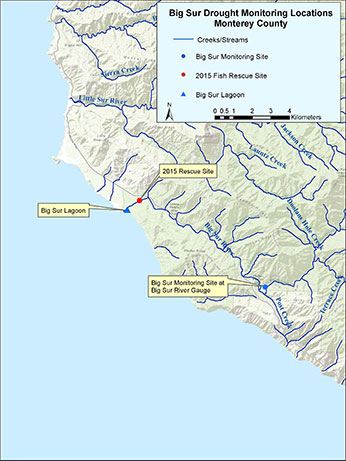 Figure 2. Map of drought monitoring locations on the Big Sur River.(click/tap to enlarge)
Figure 2. Map of drought monitoring locations on the Big Sur River.(click/tap to enlarge)
Central California coastal rivers and streams are typically smaller in size compared to those in the northern California coast and in the Central Valley. South-Central California Coast Steelhead in this area are listed as threatened under the Federal Endangered Species Act (Figure 1). Historically, these fish were more abundant, but over the course of the last several decades, populations in the Central California Coast have decreased due to a variety of anthropogenic impacts including dam construction, water management and diversions, as well as habitat degradation through poor land use practices. These impacts were enough for steelhead populations to decline even though California was experiencing a wetter climate in the last 150 years, a climate which does not represent the norm in California’s paleoclimate record (Ingram 2013).
Within Monterey County, the Big Sur River is located in a relatively rural area and has no dams (Figure 2). Under normal rainfall conditions, the Big Sur River typically maintains a wetted channel to the lagoon which is generally open year-round.
Need for Drought Stressor Monitoring
USGS defines “water years” as the 12-month period beginning on October 1st of every year. According to California Department of Water Resources, water years 2014 and 2015 (third and fourth years of a multi-year drought cycle) have been two of the driest years on record in California, compounding stressors on aquatic and terrestrial species (CDWR 2014).
Rainfall in the town of Big Sur during 2014 and 2015 was below annual average rainfall (44.91 inches) for both years. In 2014, total rainfall was 37.23 inches (82% of average), and half of this fell in a short time period (December), quickly draining to the ocean. Ideally, for steelhead, flows should occur in a more protracted period throughout winter into spring to provide enough stream flow to allow adult steelhead access from the ocean into the river for spawning and then outmigration of juvenile steelhead “smolts” back to the ocean for growth. In 2015, total rainfall was 11.92 inches, or 26% of average, lower than it was in 2014 (United States Climate Data). Due to the severity of the drought, the Governor declared a state of emergency and established water conservation and monitoring measures. To get a sense of stream conditions and possible drought effects on aquatic organisms, primarily steelhead, CDFW has been monitoring river conditions over the last two years.
Stressor Monitoring Efforts
 Figure 3. Big Sur River monitoring site at USGS gauge 11143000. (CDFW photo)
Figure 3. Big Sur River monitoring site at USGS gauge 11143000. (CDFW photo)
CDFW has collected stressor monitoring data on the Big Sur River on a weekly basis since March 14, 2014. Data is collected on water clarity, dissolved oxygen, water temperature, flow, and on steelhead migration barriers, which have been created, by reduced flows and dried streambed conditions. Stream connectivity with the estuary/lagoon and the Pacific Ocean was documented, as well as algal growth conditions, and any other notable physical changes. CDFW used a water quality (YSI 556 MPS) meter to measure temperature and dissolved oxygen, as well as the existing United States Geological Survey (USGS) stream gauge, located approximately 7.5 miles upstream from the river’s mouth, for flow information (Figure 3). This effort is in addition to CDFW’s earlier instream flow studies at the Big Sur River to develop flow regime recommendations to the State Water Resources Control Board.
Findings
In 2014, low streamflow conditions persisted after the early spring rains decreased in magnitude and stopped. This resulted in flows of less than 20 cfs during the spring and flows of less than 15 cfs during the summer and fall. These flows are lower than average (called Critically Dry Flows) from May through November and are less than the 22–25 cfs needed for steelhead spawning and rearing in the river (Holmes and Cowan 2014, Figure 4). Only with the onset of storm events in December did flows increase, but they quickly returned to near pre-storm flows due to the overall dry condition of the watershed. Likely, fish were able to immigrate as a result of temporary higher flows. A similar streamflow pattern continued into 2015. However, low streamflow (less than 15 cfs) persisted for seven months from summer through winter, despite rainfall events that occurred in December (Figure 6). The steelhead population is expected to have been further negatively affected by the prolonged low flow period.
During the summer months, stream temperatures reached as high as 17.2 oC in 2014 and 15.8 oC in 2015 (Figures 4 and 6). Although low flows were experienced from July through September of both years, dissolved oxygen levels remained high, creating suitable conditions for steelhead in area with enough water. In 2014, dissolved oxygen stayed above 8 mg/l and in 2015, above 9 mg/l (Figures 5 and 7). Dissolved oxygen concentrations greater than 7 mg/l are considered to be at healthy levels for steelhead (Barnhart 1986).
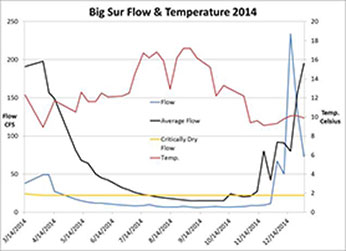 Figure 4. Big Sur flow and temperature in 2014. (click/tap to enlarge)
Figure 4. Big Sur flow and temperature in 2014. (click/tap to enlarge)
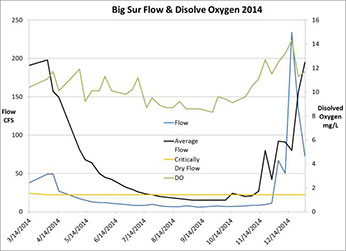 Figure 5. Big Sur flow and dissolved oxygen in 2014. (click/tap to enlarge)
Figure 5. Big Sur flow and dissolved oxygen in 2014. (click/tap to enlarge)
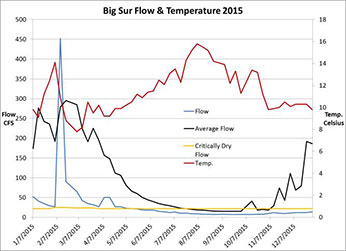 Figure 6. Big Sur flow and temperature in 2015. (click/tap to enlarge)
Figure 6. Big Sur flow and temperature in 2015. (click/tap to enlarge)
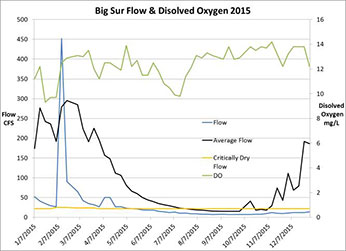 Figure 7. Big Sur flow and dissolved oxygen in 2014. (click/tap to enlarge)
Figure 7. Big Sur flow and dissolved oxygen in 2014. (click/tap to enlarge)
From October 1 to November 26, 2014, the river dried back approximately 0.25 mile from Andrew Molera State Park to a log jam located just upstream of the lagoon. Another stream dryback occurred from September 9 to November 27, 2015. This was an atypical condition for the river as compared to other average rainfall years (Figure 8). Drybacks stranded and killed juvenile steelhead and increased the opportunity for predation by birds, raccoons, and other wildlife.
 Figure 8. Big Sur River fish rescue and dry back site downstream of Andrew Molera State Park. . (CDFW photo)
Figure 8. Big Sur River fish rescue and dry back site downstream of Andrew Molera State Park. . (CDFW photo)
Prior to the drybacks occurring in 2015, the mouth of the Big Sur River closed on August 1, 2015 and remained closed until December 2, 2015. In average rainfall years, the Big Sur River Lagoon typically remains open, so this represented an unusual condition for the lagoon, which blocked steelhead immigration and emigration. On September 10 and 15, 2015, CDFW conducted a fish rescue in the response to the anticipated stream dryback in the potentially affected area. This rescue resulted in moving 105 juvenile and one adult steelhead downstream to the lagoon.
In winter 2015, a spawning ground survey was conducted to estimate the number of adult steelhead. The survey was from the lagoon to the upstream limit of steelhead access (called the limit of “anadromy”), a distance of approximately nine miles. Only nine steelhead nests (called “redds”) were found.
The conditions documented during the last two years show flow was the limiting factor for steelhead since it fell below the critically dry threshold for many months in both years. The low flow conditions that persisted for several months, which led to stream drybacks, resulted in reduced habitat availability and ability to move between habitats, increased potential for predation, and reduced food supply/delivery in the form of aquatic insect production in the river.
Future Efforts
In California, it is too early to know how Water Year 2016 will compare to previous years of drought. Even if 2016 is determined to have higher than average rainfall, it is highly unlikely that there will be a replenishment of the estimated 11 trillion gallons of water needed for the State to recover from the previous four years of drought. Therefore, drought conditions throughout the state and at the Big Sur River will likely persist. The first two years of this planned long-term stressor study has enabled the collection of valuable data in terms of not only documenting stream flow conditions during a severe drought, but also providing context for potential stream response as global warming affects a drier and more stochastic climate over time. This effort is also valuable in identifying stream flow as a critical limiting factor for steelhead, specifically as it relates to adult immigration, juvenile emigration, successful spawning and rearing, and population recruitment. Coupled with the competing human water demands, steelhead populations are going to have extreme challenges to persist overtime when all life stages are adversely impacted by the documented lack of flow over multi-year drought conditions.
References
- Barnhart, R. 1986. Species profiles: life histories and environmental requirements of coastal fishes and invertebrates (Pacific Southwest). U. S. Fish Wildlife Biological Report 82 (11.60). U. S. Army Corps of Engineers. TREL 82-4. 21 pages.
- CDWR, 2014. Breaking Drought News. WRCC climate region dry years, ranked by inches of precipitation. Access May 06, 2014
- Holmes, R. W. & Cowan, W. Instream Flow Evaluation Steelhead Spawning and Rearing Big Sur River, Monterey County, CDFW, Water Branch, July, 2014.
- Ingram, B.L., et al. The West Without: Water What Past Floods, Droughts, and Other Climatic Clues Tells Us About Tomorrow. Berkeley and Los Angeles: University of California Press, 2013.
- United States Climate Data.
CDFW